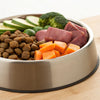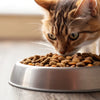Should You Wet Dog Kibble? Exploring the Pros and Cons
- Houndsy
Table of Contents
- Introduction
- The Case for Wetting Dog Kibble
- The Drawbacks of Wetting Dog Kibble
- Tips for Wetting Dog Kibble
- Conclusion
- FAQs
Introduction
As dog owners, we constantly seek ways to enhance our furry friends' lives, particularly regarding their nutrition. Did you know that about 70% of dogs can be picky eaters? This statistic highlights the struggle many pet parents face when trying to ensure their pups consume a balanced diet. One question that often arises in the quest for better nutrition is: Should you wet dog kibble?
In this blog post, we will explore the implications of adding water to dry dog food, delving into the benefits and drawbacks of this practice. We aim to provide a comprehensive understanding of how moistening kibble might impact your dog's hydration, nutrition, and overall health. By the end of this article, you will be equipped with the knowledge to make an informed decision regarding your pet's feeding routine.
Our discussion will cover various aspects, including how adding water can enhance palatability, assist with hydration, and aid digestion. We’ll also address potential downsides, such as spoilage risks and dental health concerns. Additionally, we'll provide practical tips for safely incorporating this method into your dog’s diet.
As we venture through this topic, we invite you to reflect on your own pet's feeding habits and consider whether wetting their kibble could enhance their mealtime experience.
The Case for Wetting Dog Kibble
Enhanced Palatability
One of the primary reasons pet owners consider adding water to dry kibble is to improve its taste and aroma. Just like humans, dogs can have their preferences when it comes to food texture and flavor. When you introduce water to kibble, it can unlock and intensify the flavors, making the meal more enticing for your furry friend.
For instance, if you have a finicky eater, adding warm water to kibble can significantly increase its appeal. The warmth helps release the enticing aromas of the food, often coaxing even the pickiest of pups to dig in. This simple change can transform a mundane meal into a gourmet experience without resorting to gourmet dog food or additional additives.
Assisting Hydration
Hydration is crucial for your dog's health, impacting everything from digestion to overall well-being. Many dogs do not drink enough water daily, which can lead to dehydration and its associated health risks. By moistening kibble, you are effectively adding an extra source of hydration to their diet.
For dogs that are reluctant drinkers or those who live in warmer climates, this can be especially beneficial. Soaked kibble provides a dual benefit by offering both nutrition and hydration in one meal. This is particularly important for breeds prone to urinary issues or kidney problems, as adequate hydration is vital for maintaining their health.
Aid in Digestion
Wetting kibble can also ease the digestion process. Softening the food makes it easier for dogs—especially senior dogs or those with dental problems—to chew and swallow. This can be a game changer for pets that struggle with hard kibble.
Additionally, the softened food can be gentler on your dog's stomach, potentially reducing the risk of gastrointestinal upset. For dogs recovering from illness or those with sensitive stomachs, moistened kibble can be a kinder option that supports their digestive health.
Dental Health Considerations
While many believe that dry kibble helps maintain dental health by scraping away plaque as dogs chew, this is not universal. For dogs with dental issues, wetting kibble can provide a more comfortable eating experience. It reduces the risk of oral injury and allows them to enjoy their meals without discomfort.
For dogs that find chewing hard kibble to be a challenge, moistening their food can encourage them to eat without fear of pain, ensuring they receive the nutrition they need.
The Drawbacks of Wetting Dog Kibble
Potential for Spoilage
One significant downside of adding water to kibble is the risk of spoilage. When kibble is soaked, it creates an environment that can foster bacterial growth, especially if left out for too long. Spoiled food can lead to gastrointestinal distress and other health issues in dogs.
To mitigate this risk, it's essential to serve the hydrated kibble immediately and discard any uneaten portions after about 60 minutes. This practice is particularly crucial during warmer months when bacterial growth can accelerate.
Dental Problems
While wetting kibble can benefit dogs with existing dental issues, it may also pose risks for those without dental problems. The abrasive texture of dry kibble helps to scrape away plaque and tartar as dogs chew. By softening the kibble, you may reduce this natural dental cleaning effect, potentially leading to increased plaque buildup over time.
If dental health is a concern for your dog, it's essential to weigh these factors carefully. Consult your veterinarian to determine the best approach for maintaining your dog's oral hygiene.
Loss of Nutritional Value
Adding water to kibble can also alter the nutritional profile of the food. Some vitamins and minerals may leach into the water, particularly if the kibble is allowed to soak for an extended period. While this loss may not be significant, it could lead to deficiencies if the moistened kibble becomes a regular part of your dog's diet.
For this reason, it's advisable to consult with a veterinarian or a pet nutritionist if you plan to make this a regular practice. They can help you ensure that your dog's nutritional needs are still being met.
Overeating Risks
When kibble is soaked, it may become more appealing and easier to consume, which could inadvertently lead to overeating. Dogs that typically gobble their food may eat even faster when it’s softened, increasing the risk of bloating or other digestive issues.
To avoid this, monitor your dog's eating habits when introducing wet kibble. You might consider using a slow feeder or measuring out portions to ensure that your pup isn't consuming too much too quickly.
Soggy Kibble Concerns
Some dogs may find soggy kibble unappealing and refuse to eat it. If your dog is accustomed to dry kibble, the change in texture could deter them from their meal. It's essential to introduce the concept gradually, allowing your dog to adjust to the new texture over a few days.
Tips for Wetting Dog Kibble
If you decide to try moistening your dog's kibble, here are some practical tips to get started safely:
- Start Slowly: Introduce small amounts of water to your dog’s kibble to see how they react. Gradually increase the amount as they adapt to the new texture.
- Use Warm Water: Warm water can enhance the aroma and flavor of the kibble, making it more enticing. However, avoid using hot water, as this could burn your dog’s mouth.
- Serve Immediately: To prevent spoilage, serve the hydrated kibble immediately and discard any leftovers after 60 minutes.
- Monitor Your Dog’s Response: Watch how your dog reacts to the wet kibble. If they seem to enjoy it and digest it well, you can continue with this practice.
- Consult Your Veterinarian: If you have any concerns about your dog's diet or health, always consult with your veterinarian for personalized advice.
Conclusion
In conclusion, the question of whether you should wet dog kibble depends on your dog's individual needs and preferences. Adding water can enhance palatability, assist with hydration, and aid digestion, making it a beneficial practice for many dogs. However, it’s essential to be aware of the potential drawbacks, including spoilage risks, dental health considerations, and possible nutritional loss.
We encourage you to reflect on your own pet’s feeding routine and consider whether incorporating water into their kibble could elevate their mealtime experience. For a seamless feeding experience that combines convenience, design excellence, and quality, explore our flagship product, the Houndsy Kibble Dispenser. It ensures perfect portions and maintains the freshness of your dog’s food, making feeding time simpler and more enjoyable for both of you. Order now to elevate your dog-feeding experience.
FAQs
1. Is it safe to add water to my dog's kibble?
Yes, adding water to kibble can be safe and beneficial for many dogs, especially those with dental issues or those that need help staying hydrated. However, monitor for any spoilage and be cautious of potential dental health impacts.
2. How much water should I add to my dog's kibble?
Start with a small amount of water, gradually increasing as your dog becomes accustomed to the texture. A general guideline is to add enough water to soften the kibble without turning it into a mushy consistency.
3. Can adding water to kibble help with digestion?
Yes, moistened kibble can be easier for dogs to chew and digest, particularly for older dogs or those with sensitive stomachs.
4. Does wetting kibble reduce its nutritional value?
There is a possibility that some vitamins and minerals could leach into the water. It's advisable to consult with a veterinarian to ensure your dog’s nutritional needs are met if you regularly moisten their kibble.
5. How can I prevent spoilage when adding water to kibble?
Serve the hydrated kibble immediately and discard any leftovers after about 60 minutes to reduce the risk of bacterial growth.












